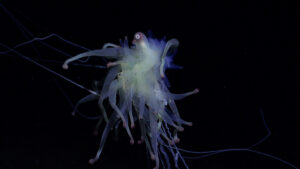Sometimes, the natural world is not just beautiful, it’s weird: lakes of fire, bleeding waterfalls, smoking hills, toxic brine pools. And on the little island of Trinidad is one such peculiar sight, sometimes praised as the Eighth Wonder of the World but more simply known as the Pitch Lake.

Some of the Pitch Lake’s many sulphur pools. Photo: Richard Seaman
Located outside the town of La Brea, Trinidad, the Pitch Lake is the world’s largest natural deposit of asphalt. It is one of eight that exist. The others are in Azerbaijan, Oklahoma, California, and Venezuela. Los Angeles’s famous La Brea Tar Pits is one of them.
Pitch Lake contains 10 million tons of asphalt, spans more than 44 hectares, and is 75m deep. It’s thought to lie on a subduction zone, where one of earth’s tectonic plates slides under another. Here, methane, hydrogen sulphide, and carbon dioxide rise to the surface in the form of oil. When the oil meets open air, the lighter particles evaporate, and the denser, thicker patches create a hard, semi-solid surface on which you can walk. The lake has a sort of “elephant skin” texture from its mixture of clay, dirt, sand, and oil.
It is possible that the very roads you drive on were built with this Trinidadian pitch. The roads leading to Buckingham Palace in Great Britain and the Lincoln Tunnel in the U.S. certainly were. Unknown to many, this frequent industrial extraction for road building, together with its position on a fault line, have caused the lake to move at a minuscule rate.

Photo: Viator
During the rainy season, water accumulates in cracks and dips in the pitch, creating subtle sulphur pools in which you can soak and reportedly cure most skin ailments. The lake supports different ecosystems in different areas: Some pools contain fresh water, some saltwater, others sulphur water, allowing various forms of life to thrive. Fish that were washed inland from rivers and ocean tides have made a home in the fresh and saltwater ponds, while algae and lily pads further enrich this seemingly dead lake.

Life thrives in this seemingly barren area. Photo: Sherman’s Travel
Many say that the lake is alive. It tends to make strange noises as visitors walk on the surface and as the pitch heats and cools during the day. Soft spots in various sections act like quicksand.
La Brea is Spanish for tar or pitch, but otherwise, even the pronunciation of Trinidad’s and Los Angeles’s is different. Trinidadians call it “La Bray”. At the end of the 16th century, Sir Walter Raleigh came to this island to help weaken Spanish influence. Exploring inland, he was overwhelmed by the smell of tar in the air. The native Kalinago people led him to what they believed was hell, a black lake full of a hard substance that was ideal for repairing his ship. According to the natives, the gods banished people here who ate the sacred hummingbird. The Spanish referred to it as Tierra La Brea — Land of Tar.
The Tar Pits in Los Angeles lie just off Wilshire Boulevard, a famous shopping street once known as the Golden Mile. It includes a museum with fossilized mammoths, ancient wolves, saber-toothed tigers, and prehistoric plants. Outside, in the tar pits themselves, sculptures of mammoths pose in the ooze.

Los Angeles’s La Brea Tar Pits, complete with mammoth tableau. Photo: Shutterstock
Meanwhile, Trinidad’s Pitch Lake is just outside a small village in the south of the island, in a natural setting of trees and brush. Several trees up to 3,000 years old, prehistoric animal parts (a giant sloth and mastodon tooth) and Amerindian artifacts have resurfaced and re-descended into the thick, black depths. It can swallow objects and spit out the well-preserved remains years — or thousands of years — later.
Surprisingly, the Pitch Lake has drawn few scientists and geologists. The studies that do exist (mainly by the European Space Agency) have found similarities between the Pitch Lake and similar lakes on the surface of Titan, one of Saturn’s moons. Although the Pitch Lake may look like an oversized, bumpy parking lot, some scientists believe that it might one day reveal whether or not Titan can support life.






